The MGA With An Attitude
SCOOTER CARRIER with Power Lift - TH-301
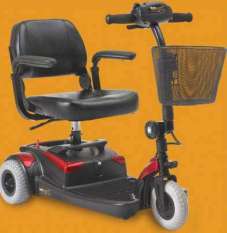
 There is an MGA enthusiast with back pains who walks with a cane but still loves to drive her MGA. She drives the MGA around her neighborhood now, but if she wants to go much farther, like to visit a friend or the shopping mall, she has to drive a big van with a drop floor to take her electric scooter along. She thinks the van is not much fun and would much rather drive her MGA. So the problem at hand is, how do you take along this thing shown at right when you like to drive the car shown below?
There is an MGA enthusiast with back pains who walks with a cane but still loves to drive her MGA. She drives the MGA around her neighborhood now, but if she wants to go much farther, like to visit a friend or the shopping mall, she has to drive a big van with a drop floor to take her electric scooter along. She thinks the van is not much fun and would much rather drive her MGA. So the problem at hand is, how do you take along this thing shown at right when you like to drive the car shown below?
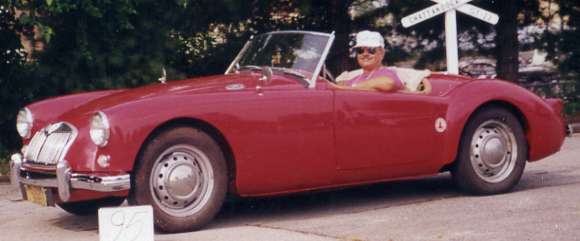
The lady thought she wanted a trailer with a power drop tail gate, and it would be nice if it was covered, weather tight, and somewhat secure. Aside from the technical problems, and the size of the trailer, there would also be a constant problem of where to park a car with trailer when you're looking for handicap parking. After a bit of head scratching, I have better solution.

The small scooter weighs just under 100 pounds. The carrier needs to be strong enough to tolerate someone who might step or sit on it, so target for the maximum load will be 250 pounds at the rear edge of the platform (with a reasonable safety factor). Target weight for the covered carrier will be under 100 pounds total, including the structural attachment, articulated platform, power lift, and dust tight cover.
The MGA starts with fairly stiff suspension, but even with this weight limit the carrier will change weight distribution significantly. The original MGA is about 2000 pounds with 50% of the weight on each axle. The new load will be close to 200 pounds positioned aft of the rear axle by about half of the wheelbase. This will result in about 900 pounds on the front axle and 1300 pounds on the rear axle, in which case we need some attention to detail to reduce tendency for the tail to wag the dog. The effect will be similar to handling issues for a rear engine car. I anticipate adding a pair of small helper leaves to the rear springs, increasing air pressure in the rear tires, and possibly adding a sway bar (somewhere to be determined later). This is not intended to have race car handling, but it should at least be safe to drive in normal fashion.
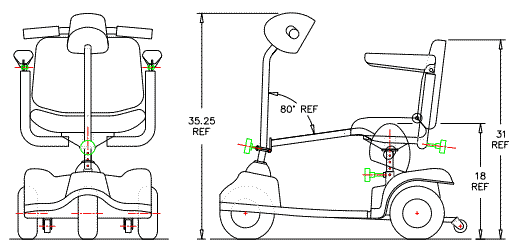
Now we get to the fun part. The assembled scooter is nearly 3 feet tall, slightly over 3 feet long, and well over 2 feet wide across the arm rests. Twist a knob and the arm rests come off and fold out flat like a hockey stick, leaving the scooter base only 21 inches wide. Pull a lever and the seat lifts off and folds over double to drop into the footwell. One more knob and the handle bars fold down on top of the power unit to be just 18 inches overall height at the center.
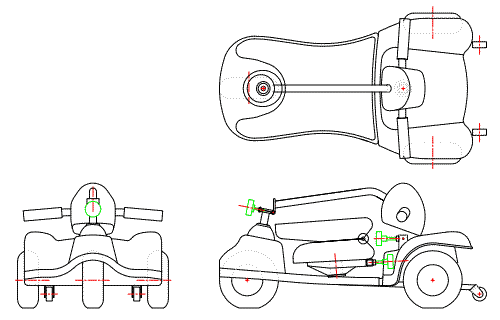
The platform will have a perimeter frame of 1"x2" rectangular tubing (on edge) with 1/8" wall thickness, and reinforcing gussets at the forward corners where pivot and latch bars attach. Platform floor will likely be sheet aluminum with non-skid surface sitting on thin steel straps that would be welded underneath the perimeter frame. Add two pieces of aluminum angle a couple inches either side of center on top of floor to serve as the center tire guide and as floor stiffeners. The platform will have a pivot shaft on the left end and a toggle clamp latching mechanism on the right side that will lock the platform securely in place for traveling.
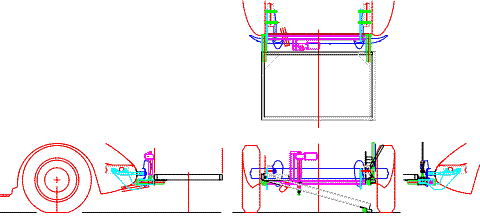
Lifting power will be provided by a 12 volt DC linear electric actuator with 400 pounds capacity and 4 inches travel. This unit will reside between the bumper face bar and front side of box. Center of the load will travel about 6 inches vertically, and lift or drop time will be about 8 seconds. At bottom of travel the lower end of the platform will sit on the ground with float distance of +/- 1-1/2 inches to allow for uneven ground. The actuator has limit clutches at both ends of travel, and the toggle latch will have an interlock switch to operate the motor only when unlatched (for one hand control). Up and down control will have a toggle switch and a key lock for security. Current draw will be about 10 amps, so with appropriate switches there will be no need for relays, but add one fuse. The electrical controls will be at right side along with the toggle clamp.
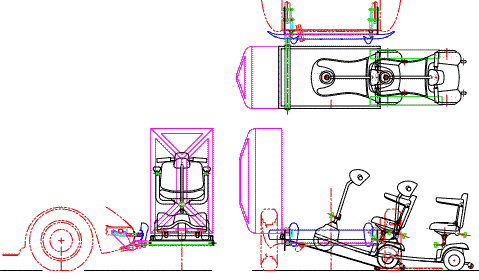
I expect the cover will have a bottom perimeter frame of 1 inch square aluminum tubing with hinge at left end and toggle latch at right end. There will be a soft rubber strip between cover and platform to provide a dust proof seal. Cover outer shell will likely be hand laid fiberglass cloth, or possibly blown in place random fiber (have to make a female mold cavity either way). It is fun figuring out how to secure the raised cover to remain vertical while the platform articulates underneath, and to make the cover stiff and light weight at the same time. Since this assembly extends slightly more than 2 feet aft of the rear bumper it will be fitted with a pair of LED trailer tail lights and a license plate lamp. You may notice the overall height is lower than the MGA rear body tonneau, and in fact even lower than the tail end of my personal luggage trailer. Not only will it not obstruct rear view, but it will hardly show in the dash mounted rear view mirror. From straight behind the MGA 1500 or 1600 type tail lights will be visible beyond ends of the box.
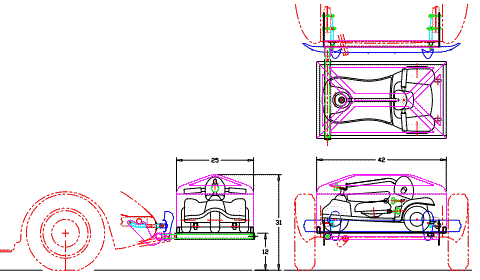
For unloading, unlatch and raise the cover, raise the handlebar and install the seat while the scooter sits at a convenient height on the platform (12 inches above ground level). Insert and turn control key, switch down, pull toggle lever to unlatch and actuate lift motor. When platform end is on ground, walk the scooter off the platform under its own motive power. Toggle switch up, lift platform, lock in place, extract key, close and latch cover. Loading is pretty much the reverse of unloading. Open cover, drop ramp, walk the scooter up the ramp under its own power, then raise platform and lock in place. There will be some form of quick toggle latch to secure the scooter to the platform for road travel. Remove arm rests and seat, stow the parts on the scooter base, close cover and latch before traveling.
The scooter has an internal magnetic brake strong enough to hold it on the 16 degree inclined ramp, but there is one little trick involved with loading. The scooter also has two small wheelie wheels on the back end intended to prevent running up on incline greater than about 5 to 7 degrees while it is being ridden. To allow the scooter to drive up this 16 degree ramp (walking along side) it will be necessary to lay down 1 inch thick planks to raise the rear tires to defeat the wheelie wheels. Always another trick. The planks will stow under the scooter in the carrier, but I would like to figure out an easy way lay them down and pick them up again. I am also considering if the platform might want some form of small rear bumper to hopefully provide some minimal protection for the box (in case of park by ear). If it gets hit with a standard height car bumper it's done anyway, but then my luggage trailer has never been hit on the back end in over 100,000 miles of towing, so maybe it not to worry about. Work in progress.
|